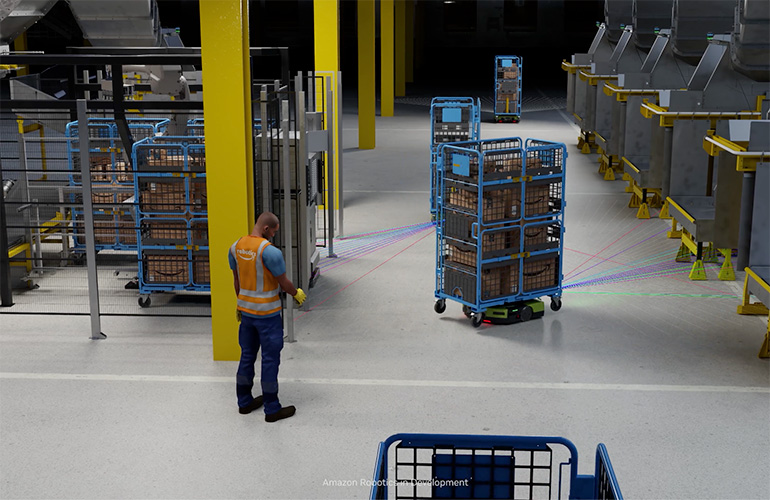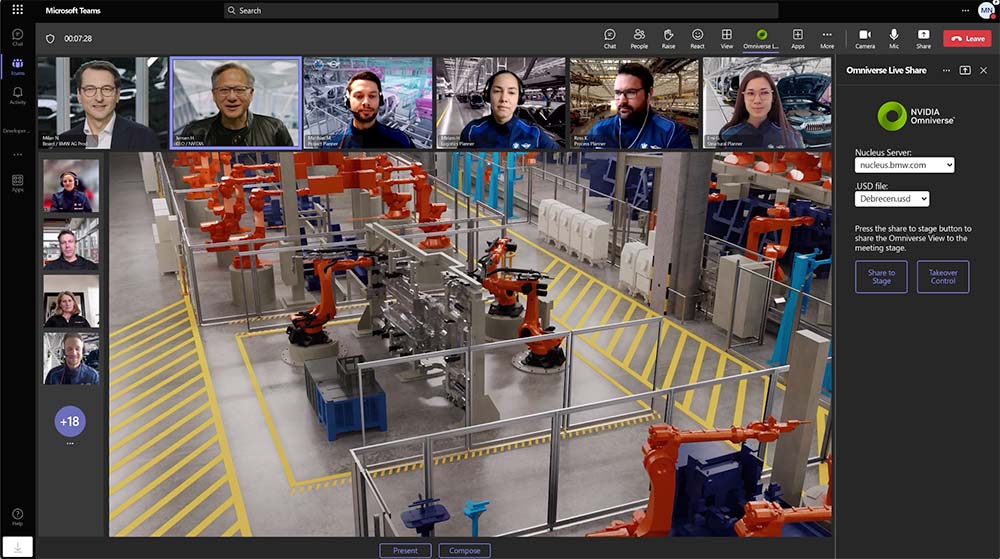|
Listen to this article  |

NVIDIA Omniverse enables Amazon Robotics engineers to quickly simulate warehouse environments and train sensor data. | Credit: NVIDIA
NVIDIA’s CEO Jensen Huang presented the latest product announcements during his keynote at the 2023 GTC event this morning.
One of the first significant announcements is that NVIDIA accelerated computing together with CUOP has solved Lee and Lim’s traveling salesman problem faster than any other solution to date. This milestone opens up a new world of capability for roboticists to create real-time solutions to AMR path planning problems.
Isaac Sim on Omniverse
Omniverse Cloud for enterprises is now available as a platform as a service (PaaS) for compute-intensive workloads like synthetic data generation and CI/CD. This PaaS provides access to top-of-the-line hardware when you need it for processing-intensive workloads. The service is rolling out with MS Azure.
Amazon Robotics is an early customer of Isaac SIM on Omniverse. The Proteus warehouse robot development team created a complete digital twin of the Proteus AMR and deployed it into Isaac SIM to help with the development and programming of the AMR.
The team generated hundreds of photo-realistic environments to train and test sensor processing algorithms, and AMR behavior. This enabled the development team to accelerate the project without the need to build and test expensive prototypes in the real world.
Isaac Sim enables sensor simulation and interactive design and can run on AWS RoboMaker, to help with world generation. It is deployable on your cloud service provider.

Mercedes is employing Omniverse to create a functional digital twin of automotive assembly lines. | Credit: NVIDIA
Mercedes is also using Isaac Sim and the Omniverse to accelerate the planning and design of new automobile assembly factories. Mercedes moved the virtual factory development to Omniverse. There, manufacturing engineers are able to layout robotics assembly workcells and virtually modify the robotics, tools and programming to optimize the workflow. Mercedes is claiming that this digital twin development process is shaving two years off the planning cycle for a new factory.

Mercedes is an early user of NVIDIA Omniverse for the development and programming of future automotive assembly lines and factories. | Credit: NVIDIA
Issac ROS DP3 release adds new perception capabilities and open-source modules
There is a new ROS DP3 release for Issac that includes a number of new features:
- New LIDAR-based grid localizer package
- New people detection support in the NVBLOX package
- GPU-accelerated 3D reconstruction for collision avoidance
- Updated VSLAM and depth perception GEM
- Source release of NITROS, NVIDIAs ROS 2 hardware acceleration implementation
- New Isaac ROS benchmark suite built

NVIDIA Omniverse and Isaac SIM enable roboticists to view the world as the sensors see it. | Credit: NVIDIA
Updates to NVIDIA Jetson ORIN Family
The Jetson ORIN product line gets an update including a new ORIN Nano unit that is available in a complete range of configurations from hobbyists to commercial platforms:
- Jetson ORIN Nano 8GB/4GB
- Orin NX 16GB/8GB
- AGX Orin 64GB/32GB
New entry-level jetson development kit for Robotics / Edge AI
NVIDIA is introducing the NVIDIA Jetson Orin Nano Developer kit
- Available now for preorder for $499
- There will be a student discount in the near future as a Nano developer kit for $149 (hobbyist level)
In a future-looking statement, NVIDIA believes that building infrastructure will evolve such that every building will be considered to be a “robot”. Practically, this implies that buildings and other infrastructure elements will be imbued with the ability to sense, think and act.
It starts with the idea to automate infrastructure with vision-based AI as a platform for things that watch other things that move. This is a vision that the company calls “NVIDIA Metropolis”
The company is released the latest generation TAO, TAO 5.0. Features include Deepstream which puts more sensors to work to help automate machinery and computer vision grand challenge with APIs.
Additional features include:
- Adds support for vision transformer
- Deploy on any device – GPU, CPU, MCUs
- TAO is now open source
- AI-assisted annotation
- REST APIs
- Integration Google Vertex AI, AzureAI, et
NVIDIA is also announcing Metropolis Microservices to solve hard problems like multi-camera tracking and human and machine interactions.
Deepstream is putting AI to work in low-code interfaces for graph composing as an expansion of existing AI services. This includes multi-sensor sensor fusion and deterministic scheduling for things like PLC controllers.
Credit: Source link


Comments are closed.